Janis's Felines
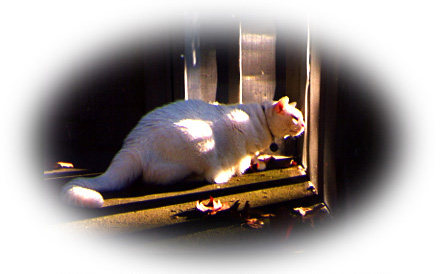
This page is dedicated to STRETCH
See Cat Fanciers: Color Genetics or The Book of the Cat, Ed. M. Wright and S. Walters, Summit Books, NY for discussion of coat color inheritance. Major loci are:
- Black (B) dominant over browns (b, b'...)
- X-linked Orange or red (O) dominant over non-orange (o)
- Dense coloring (D) dominant over dilute (d)
- Albino (C, cs, cb...), alleles display hierarchy of dominance; epistatic to Black
- White spotting (S) once thought separate from dominant white W, now possibly one gene with complex allele hierarchy
- Short hair (L) is dominant to long (l)
- Agouti (A, hair banding) dominant over solid (a)
- Tabby striping: mackerel dominant over blotched (loss-of-function in the Taqpep gene). Need to be A– at agouti and TiaTia) at ticked to see
- Ticked (TiA) is epistatic to the tabby pattern, abolishing the macro pattern of stripes. Classic mackerel or blotched cats must be homozygous for the recessive non-ticked allele (TiaTia)
Recent technical sources:
Kaelin and Barsh review: https://www.ncbi.nlm.nih.gov/pubmed/25387014
Eizirik et al Tabby: https://pubmed.ncbi.nlm.nih.gov/19858284/
Kaelin et al Ticked: https://pubmed.ncbi.nlm.nih.gov/22997338/
David et al White/spotting: https://pubmed.ncbi.nlm.nih.gov/25085922/
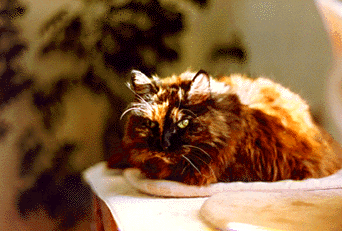 |
Puffy Mother of Wilbur, Spot, and Mombo. The orange-black tortoiseshell pattern indicates heterozygosity for X-linked orange gene, O=orange, o=not orange (ie genotype determined by Black gene on another chromosome). Orange patches result from inactivation of the X-chromosome with the o allele. Long haired, therefore two recessive long hair alleles, ll. Small white patch on chest, not visible here, indicates a weak allele for white spotting. Probably overall B– Oo ll. Black patches too small to determine if non-agouti (solid) or visible underlying tabby stripes. |
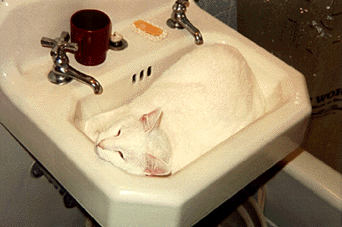 |
Wilbur Son of Puffy. When young, he was all white with orange spot on his head. The orange indicates he inherited Puffy's X-chromosome with the dominant O allele. Probably white due to strong spotting allele(s). Though some cats with the White gene (dominant allele W for white, recessive w for 'normal color') have small colored patches as kittens, he does not have blue or copper eyes, usually associated with White. Short-haired but must be heterozygous (Ll) since Puffy was long-haired. |
 |
Spot Son of Puffy. All white with black spot on head. He therefore inherited Puffy's X-chromosome with the recessive o allele, and can express the genotype at the Black locus (B–). Like his brother, extensive white spotting spared a black spot (faded with time though not as much as Wilbur's orange spot). Short-haired, heterozygous (Ll) since Puffy was ll. |
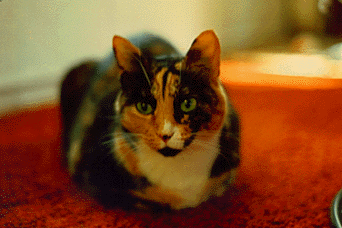 |
Mombo Daughter of Puffy. Obviously also heterozygous for orange, since she has patches of orange and black due to random X-chromosome inactivation of O (orange) and o (non-orange) alleles. Probably non-agouti as black patches show no tabby striping. White spotting makes her a traditional calico; and she must be heterozygous for hair length (Ll). |
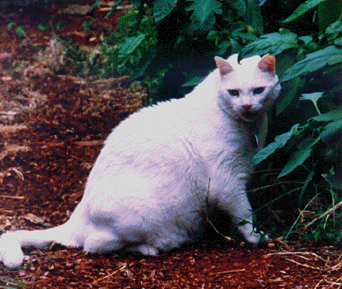 |
Stretch Stretch's completely white coat was not due to albino (recessive allele of full-pigmentation gene) since he had yellow/green, not pink or pale blue eyes. Like his unrelated fellow white boys, possibly it was a strong, homozygous, white spotting genotype. This also disguises any information on the Black, Orange, or Agouti alleles. Short haired, therefore LL or Ll. |
 |
Io As a kitten she had some distinct black hairs on the top of her head; not albino since eyes are not pink or pale blue; could be another extensive piebald spotting, possibly homozygous. Short haired, either homozygous or heterozygous. Mother was shorthaired L-, tortoiseshell Oo, some white patches (S-). All-white cats disguise the state of agouti alleles. |
 |
Winston Archetypical male orange tabby: one copy of dominant O on his single X chromosome masks his genotype at the Black locus. Shorthaired, L–. No white patches, ss (or in new scheme, w+w+). Mackerel tabby pattern. For undetermined reasons, underlying tabby patterns are always visible in orange cats, so we can't tell if he was non-agouti (aa) or Agouti (A-). |
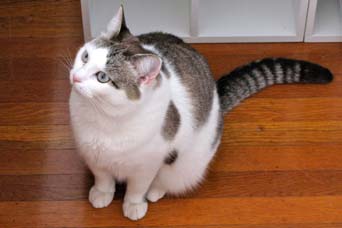 |
Frankie Her bicolor coat clearly displays a mackerel tabby pattern, no orange, and some white spotting – and is our only cat with blue eyes. The white spotting mutation affects migration of pigment cells during development. This can cause reduced pigmentation in the eyes but is thought to be uncommon in bicolors. |
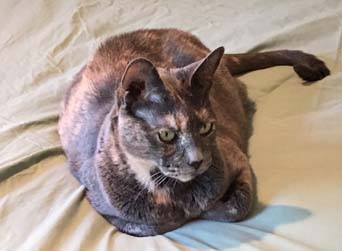 |
Addy The faded, patchy grey/cream patches of her coat are consistent with tortoiseshell, that is, Oo on the X, but the faded color is due to homozygosity for the dilute allele. Pattern also too small to clearly discern any tabby markings and agouti status. Short haired. Overall B–, Oo, dd, ss, L–. |
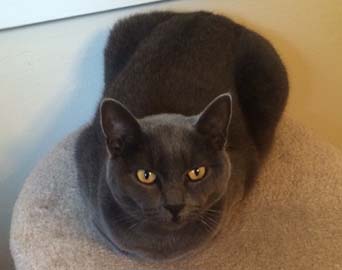 |
Smokey Another pair of dilute alleles make Smokey's B– coat appear grey, and no visible hair banding or tabby pattern is consistent with non-agouti. No white spotting; short-haired, no orange. B–, dd, oo, ss, L–. |
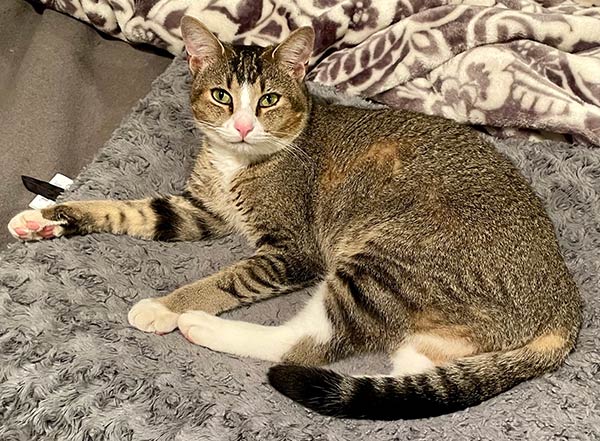 |
Chip Our first Ticked tabby! Ticked is a separate gene that affects the tabby pattern (otherwise mackerel or recessive blotched). A semi-dominant mutation abolishes big stripes, leaving an overall homogeneous appearance; each hair exhibits a flecking of cream on a black (B–) background. The gene is Dickkopf4 (Kaelin et al.) and in the heterozygous state leads to striping on the legs and tail, which appears to be the case for Chip. Also likely heterozygous for white spotting, clearly non-orange, and tthe individual flecking is indicative of dominant Agouti (A-). |